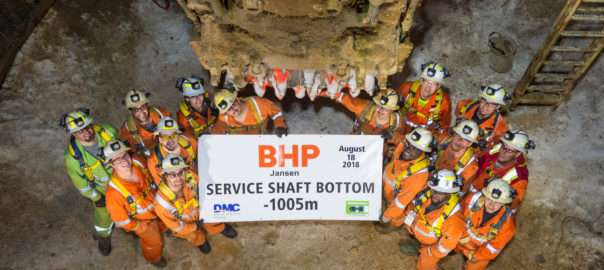Herrenknecht used the Bauma 2022 stage last month to reveal details about its latest mechanised shaft sinking solution for mining, the Shaft Boring Cutterhead (SBC).
The company, which has successfully delivered its Shaft Boring Roadheader (SBR) to soft-to-medium rock sinking applications in mining, has equipped its latest concept for hard rock up to 250 MPa uniaxial compressive strength (UCS), with the machine able to carry out cutting, lining and mucking operations concurrently.
The SBC’s specification is based on the experiences from six past mechanised shaft sinking projects and was developed in tandem with a global shaft sinking company Redpath Deilmann.
Two of the projects that influenced the design used the SBR – the blind sinks at BHP’s Jansen mine in Canada and Slavkaliy’s Nezhinsky mine in Belarus. The company has also supplied two SBRs to Anglo American’s Woodsmith mine, with one already carrying out sinking operations.
Redpath Deilmann operates SBR shaft sinking operations at Woodsmith, with DMC Mining previously in charge of sinking operations at the Jansen project.
“This new generation of blind shaft machinery aims to update and adapt existing technology to current conditions and requirements,” Martin-Devid Herrenknecht, Member of the Board of Management, says.
Speaking in Munich in a presentation titled ‘Mechanised sinking of deep shafts in hard rock’, Patrick Rennkamp, Product Manager Mining, Herrenknecht, said the SBC had been designed for shaft diameters up to 9 m and shaft depths of circa-1,500 m. The machine weight starts from 450 t and it is 45 m in length.
One of the unique elements Rennkamp highlighted was the pneumatic mucking system on board the SBC.
Building on a similar system used for the SBR, the mucking process on the SBC is tied to the circular motion of the cutter discs situated on the full-face cutterhead. The movement of the discs and suction, combined, ensures the machine only cuts the material once, Rennkamp explained to IM on the side lines of the event, reducing wear on the cutters and keeping the machine cutting for longer.
The design ensures that the cut material filters into the centre of the machine where the suction element is most effective. The cuttings then go up the suction pipe into a suction box before being filtered into coarse and fine material and blown further upwards where they can be transported to another overhead station for removal – via buckets – to surface.
Like the SBR, the machine has a gripper system to keep it in place within the shaft. There is also a lining area directly above the grippers and further work decks for concurrent work.
The company is targeting sinking rates of 6-8 m/d with the new SBC. While this is short of the progress traditional TBMs make in horizontal developments, it is quicker than traditional drill and blast methods used for blind sinking.
Herrenknecht had a team of some 40 working on the development of the SBC at its Schwanau facility in Germany. This is complemented by a team at Redpath Deilmann’s facilities in Germany, who are also providing input to the project.
To this point, the company has carried out 600 tests with different sizes of material, completing some 9 m of shaft sinking in 30-40 MPa UCS concrete with a demonstration rig that is 1:3 the size of the full-size machine.
The next steps are to invite potential customers to supply their own material for testing on the rig and validate the hard-rock cutting potential.








